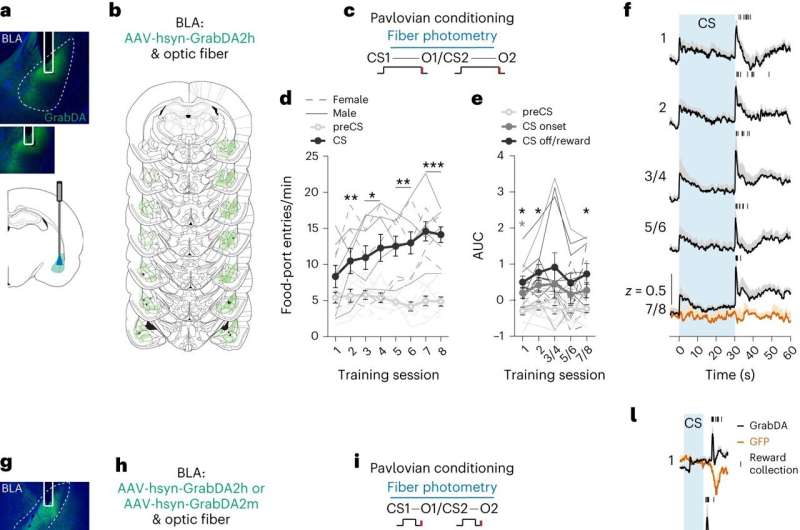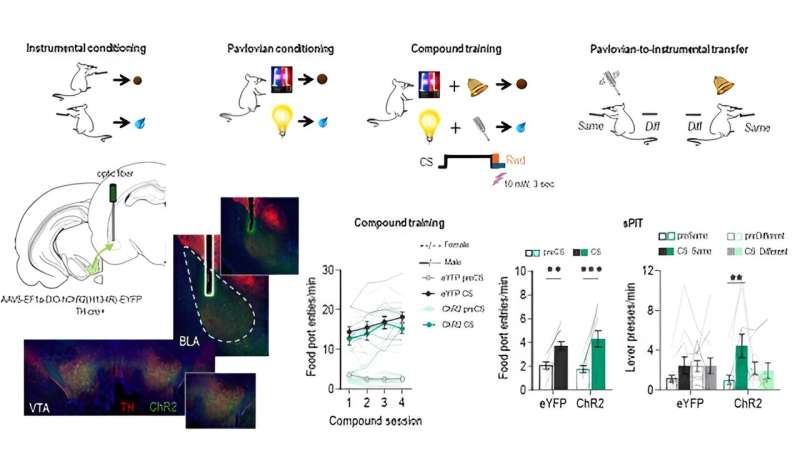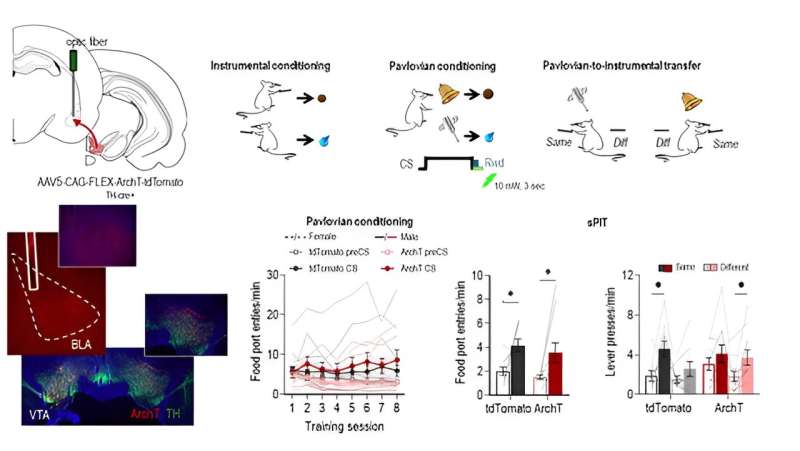April 12, 2024 feature
This article has been reviewed according to Science X's editorial process and policies. Editors have highlighted the following attributes while ensuring the content's credibility:
fact-checked
peer-reviewed publication
trusted source
proofread
Study finds that dopamine projections to the amygdala contribute to encoding identity-specific reward memories

Over the course of their lives, humans build subjective internal models outlining the associations between specific environmental stimuli and rewards that could be gained from interacting with them. These experience-based models allow them to infer what benefits they could gain from acting in specific ways.
Researchers at University of California, Los Angeles recently carried out a study investigating how the brain encodes identity-specific reward-related memories within these cognitive models. Their findings, published in Nature Neuroscience, suggest that dopamine projections to the basolateral amygdala contribute to the encoding of these memories.
"The canonical theory of dopamine function suggests dopamine encodes reward prediction error signals that cache a reward's value to its predictors," Ana Sias, co-author of the paper, told Medical Xpress. "Yet a growing body of research has challenged this value-centric framework, suggesting a multifaceted role for dopamine in facilitating learning and memory more generally.
"In this work we were interested in understanding how dopamine might contribute to forming detailed stimulus-outcome memories that link external cues to the specific identity of the rewards they predict through projections to downstream targets."
In their previous studies, Sias and her collaborators found that the basolateral amygdala is a central hub for detailed reward-related memories. In their recent paper, they built on these findings, specifically examining dopamine projections to this part of the amygdala while rats completed a reward-based decision-making task.

"We used a decision-making task that requires successful learning of identity-specific reward memories to enable adaptive choice behavior," Sias explained.
"Using fluorescent dopamine biosensors in addition to cell and projection-specific optical manipulation techniques, we show that dopamine is released in the BLA during stimulus-outcome learning, that this dopaminergic transmission is necessary to form these associations, and finally that activation of these projections is sufficient to drive stimulus-outcome learning."
Recent findings suggest that dopamine neurons contribute to building internal models of the environment that the brain then uses to predict future outcomes during decision-making. The experiments carried out by Sias and her colleagues confirm this hypothesis and go one step further, suggesting that dopamine projections to the basolateral amygdala drive the encoding of identity-specific memories, which are a central part of these internal models.
"Our research merges modern systems neuroscience tools with complex paradigms used by learning theorists to reveal projections to the basolateral amygdala as a means through which dopamine mediates this function," Sias said.
"Dopamine inputs to the BLA are necessary and sufficient to drive detailed stimulus-outcome memories but do not promote general reinforcement. While these findings are seemingly at odds with canonical theories of dopamine function, our work more broadly suggests that disparate findings of dopamine's contribution to learning and memory may be reconciled by further investigation of distinct downstream targets."

The results of this recent study could soon inform further research into the neural processes underpinning the encoding of reward-related memories in rats, humans, and other animals. These efforts could shed a new light on the complex intricacies of decision-making and the development of experience-based mental maps outlining associations between stimuli and rewards.
"Going forward, we're really interested in investigating the information dopamine conveys to the BLA to drive stimulus-outcome learning," Sias added. "Whether these projections signal a prediction error, salience, or some other essential attribute of the learning environment is unknown."
More information: Ana C. Sias et al, Dopamine projections to the basolateral amygdala drive the encoding of identity-specific reward memories, Nature Neuroscience (2024). DOI: 10.1038/s41593-024-01586-7.
© 2024 Science X Network





















